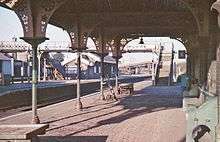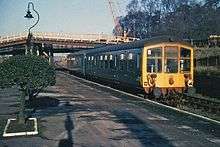Sandy railway station
| Sandy | |
|---|---|
|
| |
| Location | |
| Place | Sandy |
| Local authority | District of Central Bedfordshire |
| Grid reference | TL177487 |
| Operations | |
| Station code | SDY |
| Managed by | Great Northern |
| Number of platforms | 2 |
| DfT category | E |
|
Live arrivals/departures, station information and onward connections from National Rail Enquiries | |
| Annual rail passenger usage* | |
| 2012/13 |
|
| 2013/14 |
|
| 2014/15 |
|
| 2015/16 |
|
| 2016/17 |
|
| History | |
| Key dates | Opened 7 August 1850 |
| Original company | Great Northern Railway |
| Pre-grouping | Great Northern Railway |
| Post-grouping |
London and North Eastern Railway Eastern Region of British Railways |
| National Rail – UK railway stations | |
| * Annual estimated passenger usage based on sales of tickets in stated financial year(s) which end or originate at Sandy from Office of Rail and Road statistics. Methodology may vary year on year. | |
|
| |
Railways in Sandy | ||||||||||||||||||||||||||||||||||||||||||||||||||||||||||||||||||||||||||||||||||||||||||||||||||||||||||||||||||||||||||||||||||||||||||||||||||||||||||||||||||||||||||||||||||||||||||||||||||||||||||||||||||||||||||||||||||||||||||||||||||
|---|---|---|---|---|---|---|---|---|---|---|---|---|---|---|---|---|---|---|---|---|---|---|---|---|---|---|---|---|---|---|---|---|---|---|---|---|---|---|---|---|---|---|---|---|---|---|---|---|---|---|---|---|---|---|---|---|---|---|---|---|---|---|---|---|---|---|---|---|---|---|---|---|---|---|---|---|---|---|---|---|---|---|---|---|---|---|---|---|---|---|---|---|---|---|---|---|---|---|---|---|---|---|---|---|---|---|---|---|---|---|---|---|---|---|---|---|---|---|---|---|---|---|---|---|---|---|---|---|---|---|---|---|---|---|---|---|---|---|---|---|---|---|---|---|---|---|---|---|---|---|---|---|---|---|---|---|---|---|---|---|---|---|---|---|---|---|---|---|---|---|---|---|---|---|---|---|---|---|---|---|---|---|---|---|---|---|---|---|---|---|---|---|---|---|---|---|---|---|---|---|---|---|---|---|---|---|---|---|---|---|---|---|---|---|---|---|---|---|---|---|---|---|---|---|---|---|---|---|---|---|---|---|---|---|---|---|---|---|---|---|---|---|
| ||||||||||||||||||||||||||||||||||||||||||||||||||||||||||||||||||||||||||||||||||||||||||||||||||||||||||||||||||||||||||||||||||||||||||||||||||||||||||||||||||||||||||||||||||||||||||||||||||||||||||||||||||||||||||||||||||||||||||||||||||
Sandy railway station serves the town of Sandy in Bedfordshire, England. It is on the East Coast Main Line, 44 miles 10 chains (71.01 km) from London King's Cross.[1] Sandy is managed and served by Great Northern.
Sandy station was originally built in 1850 for the Great Northern Railway; the London and North Western Railway opened an adjacent station in 1862. The stations were later merged into one, which has since undergone many changes.
The present station has two large platforms and 4 main rail lines, a pair of "up and down" slow lines used by stopping services and a pair of "up and down" fast lines used by high speed services passing through. A fifth line extends off the "up" slow line which links into the remaining sidings and original bay platforms. There is also a sixth line off the "down" slow line that links to a siding beside Platform 1.
The station platforms have been lengthened at their southern ends so that they can cope with 12-car trains, which have recently started serving the station to increase capacity and in preparation for new Class 700 trains following the completion of the Thameslink Programme.
History

The first section of the Great Northern Railway (GNR) - that from Louth to a junction with the Manchester, Sheffield and Lincolnshire Railway at Grimsby - opened on 1 March 1848, but the southern section of the main line, between Maiden Lane and Peterborough, was not opened until August 1850. Sandy was one of the original stations, opening with the line on 7 August 1850.[2][3][4]

The Sandy and Potton Railway was opened for goods traffic on 23 June 1857, and to passengers on 9 November 1857. It was later purchased by the Bedford and Cambridge Railway (B&CR), which closed the line in January 1862 for reconstruction. The line reopened on 7 July 1862, including a new station at Sandy separate from, but adjacent to, the GNR station. The B&CR was absorbed by the London and North Western Railway (LNWR) in 1865. The eastern section of the Bedford-Cambridge route (sometimes known as the Varsity Line) closed on 1 January 1968, and with it, the ex-LNWR platforms at Sandy.[4][5]
The two stations were physically adjacent, and shared an island platform. In 1917 the LNWR station was placed under the management of the GNR, and then shared the booking facilities. After the closure of the Varsity Line, the station was considerably rebuilt in the early 1970s to give a 4-track layout throughout, and platforms on the slow lines only, thus removing a 2-track bottleneck on the East Coast Main Line.[6]
Sandy railway station was the site of the English unjust enrichment case Great Northern Railway Co. v Swaffield (1874) LR 9 Exch 132, in which the defendant sent a horse to this railway station, to be collected. His employee arrived the next day, but the station master demanded that he pay livery stable costs for the night; the employee refused to pay, and did not collect the horse. The defendant arrived later, and demanded payment to compensate him for duress of goods (after the station master offered to pay livery stable costs out of pocket); after the station master refused to pay such compensation, the defendant left the horse in the possession of the station for four months during litigation. The Court of the Exchequer held the defendant liable for four months' stable costs, as the plaintiff in the case 'had not choice, unless they would leave the horse at the station or in the high road to his own danger and the danger of other people' (per Kelly CB). In this way the court recognised a limited exception to the rule that no claim for salvage be recognised by the courts outside the context of salvage in tidal waters. The stable costs were paid to the use of the defendant by way of necessity, and therefore constituted unjust enrichment.
Facilities
Sandy station has a small café inside the booking office on Platform 2. There is a large sheltered area with seating on Platform 1, and a smaller one on Platform 2. Both platforms have step-free access via the external road bridge. However the slope to the bridge is relatively steep on both sides of the railway and the footpath on the bridge is quite narrow.
In the later half of 2016, modern ticket barriers where installed at the entrance to both platforms along with a covered area to protect them from wind and rain damage. When in use, there are staff on hand if any issues arise.
The station has two modern touch screen ticket machines located in front of the booking office, and there are cycle storage facilities to the south of it. The station also has help points throughout, which were installed by former franchise holder First Capital Connect.
Services
The station is served by a half-hourly Thameslink service southbound to Horsham via London St Pancras and northbound to Peterborough. Late night southbound services terminate at London Kings Cross instead. There is an hourly service in each direction on Sundays.[7]
Route
| Preceding station | Following station | |||
|---|---|---|---|---|
| Thameslink Peterborough to Horsham | ||||
| Future Services | ||||
Line closed | East West Rail | Line closed |
||
| Disused railways | ||||
Line and station closed | Eastern Region of British Railways | Line and station closed |
||
| Historical railways | ||||
Line and station open | Great Northern Railway | Line open, station closed |
||
Future
There has been speculation that the station will be relocated from its current position in the town centre to a new site to the north of the town, at a prospective junction of East West Rail and the ECML.[8] As of February 2018, the precise route of EWR between Bedford and Cambridge remains uncertain. The track-bed of the original Varsity Line through Sandy is no longer available, having been built over.
References
- ↑ Padgett, David (October 2016) [1988]. Brailsford, Martyn, ed. Railway Track Diagrams 2: Eastern (4th ed.). Frome: Trackmaps. map 15C. ISBN 978-0-9549866-8-1.
- ↑ Gordon, W.J. (1989) [1910]. Our Home Railways. London: Bracken Books. volume II, p. 44. ISBN 1-85170-314-4.
- ↑ Awdry, Christopher (1990). Encyclopaedia of British Railway Companies. London: Guild Publishing. p. 135. CN 8983.
- 1 2 Butt, R.V.J. (1995). The Directory of Railway Stations. Yeovil: Patrick Stephens Ltd. p. 205. ISBN 1-85260-508-1. R508.
- ↑ Awdry 1990, p. 100
- ↑ Catford, Nick. "Disused Stations: Sandy (LNWR)". Retrieved 8 May 2010.
- ↑ Table 25 National Rail timetable, May 2018
- ↑ move? Biggleswade Today, 13 July 2017
External links
- Train times and station information for Sandy railway station from National Rail
Coordinates: 52°07′30″N 0°16′52″W / 52.125°N 0.281°W
- http://www.bedfordshire.gov.uk/CommunityAndLiving/ArchivesAndRecordOffice/CommunityArchives/Sandy/TheDeathOfASandyStationMaster.aspx (with photographs of both old stations)
| Wikimedia Commons has media related to Sandy railway station. |